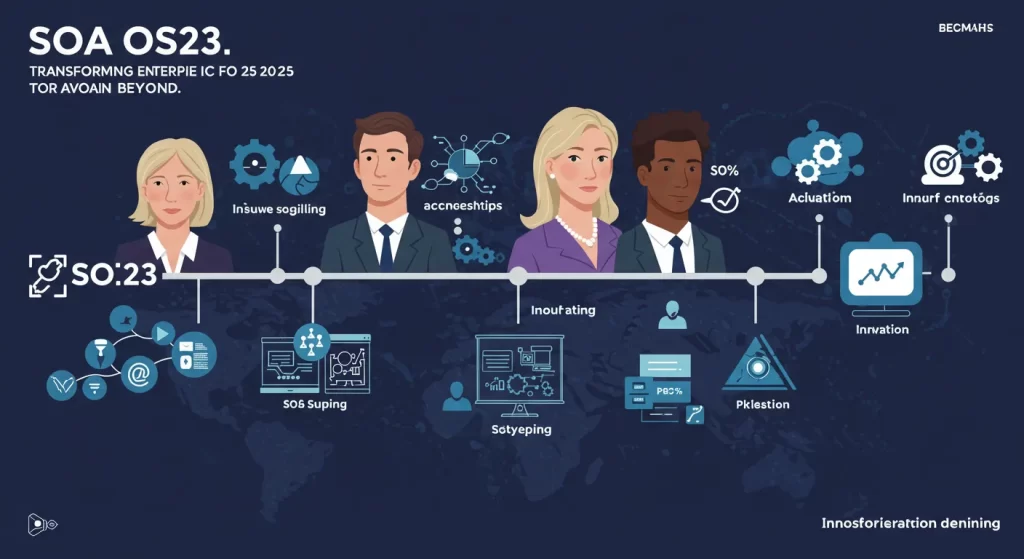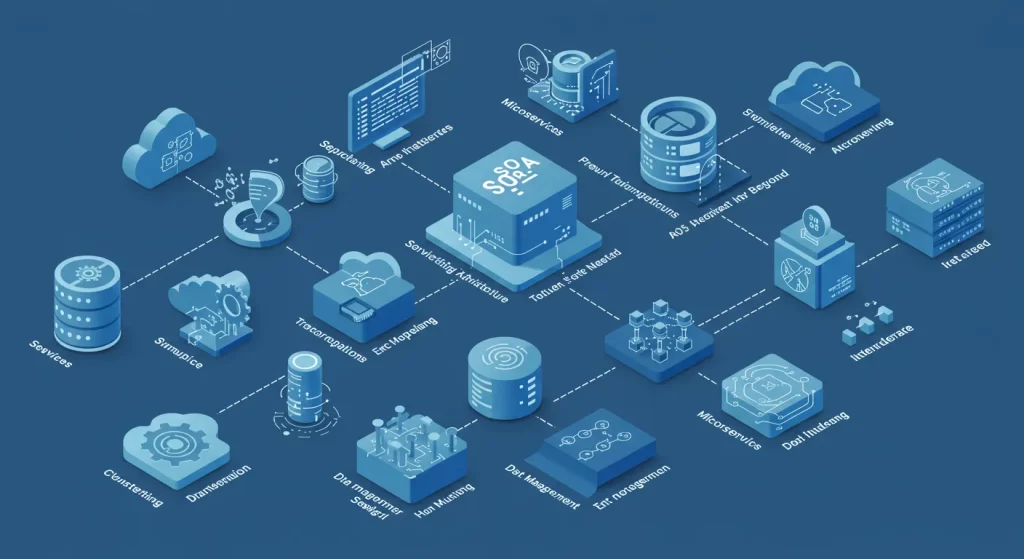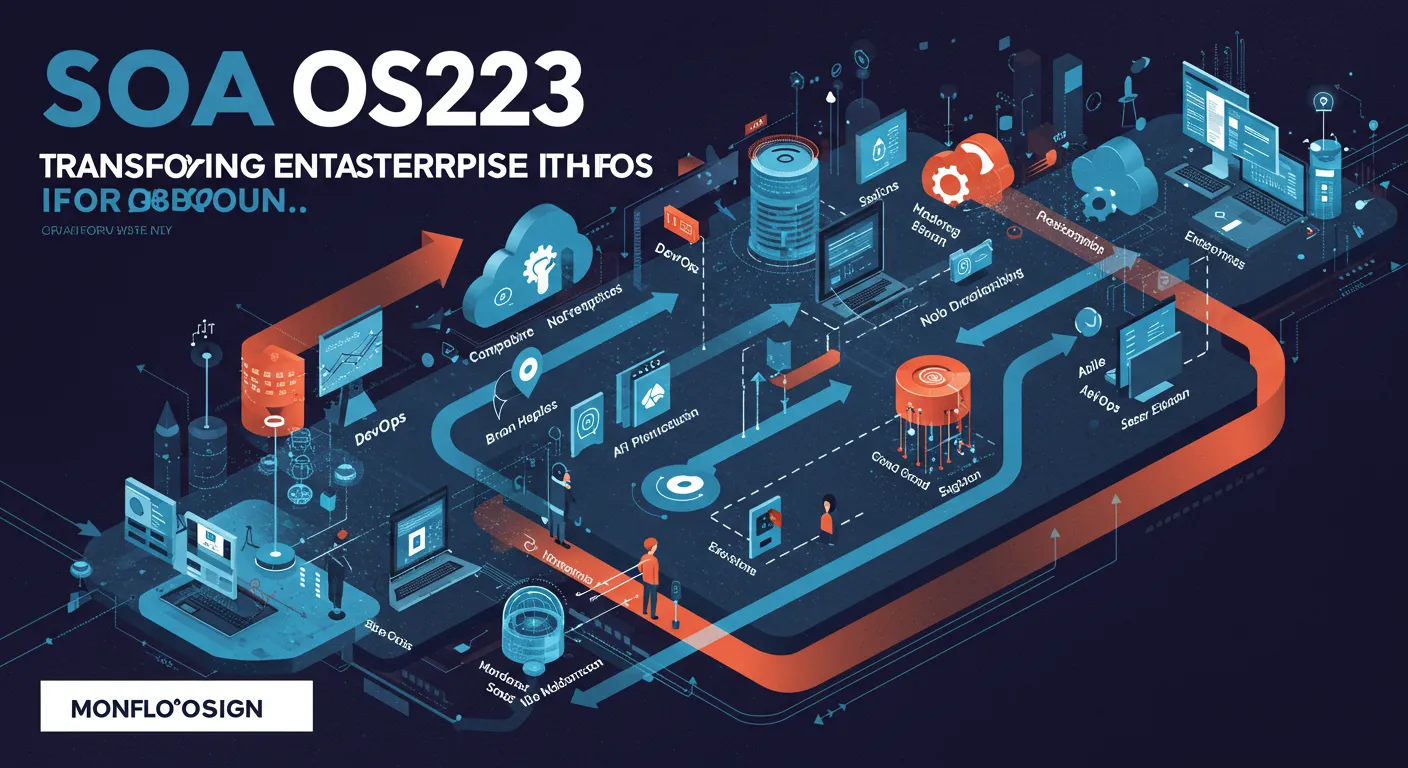Table of Contents
Technological landscape, businesses face the challenge of staying ahead of the curve in terms of scalability, interoperability, and real-time service orchestration. With an increasing demand for seamless and adaptable enterprise systems, the emergence of SOA OS23.
The latest iteration of Service-Oriented Architecture (SOA) — offers a groundbreaking approach to address these very needs. As organizations transition to next-gen digital infrastructures, SOA promises a new era of flexibility and efficiency. But what exactly does it bring to the table?
What is SOA OS23?
SOA OS23 stands for “Service-Oriented Architecture, Operating Standard 2023.” It’s a significant update to the traditional SOA model, designed to help businesses better integrate and scale their services. Unlike earlier versions of SOA, OS23 is all about interoperability, modularity, and scalability with a strong focus on event-driven services and decentralized frameworks. Key elements of SOA include:
- Event-Driven Service Hooks
- Compatibility across languages like Node.js, Python, Rust, Java, and Go
- Dynamic microservice bridging between modern and legacy systems
- Decentralized identity management
- Zero-trust security models
By incorporating these features,OS23 brings an open, vendor-agnostic approach, supported by a growing community of enterprise architects, DevOps engineers, and system integrators. It is designed to work seamlessly in containerized, high-availability environments, supporting both asynchronous workflows and real-time service orchestration.
Why SOA OS23 Matters in 2025 (And Beyond)

In the digital era, businesses are no longer just developing applications; they are constructing entire ecosystems. SOA recognizes this shift, enabling:
- Interoperability-First Logic: SOA OS23 operates independently of specific systems, programming languages, or infrastructures, making it flexible and adaptable across various platforms.
- Microservice Standardization: By unifying API structures, error handling, and response validation, OS23 simplifies the complexities of managing large-scale systems.
- Edge-Aware Computation: This architecture is designed to work seamlessly with distributed edge nodes and hybrid cloud environments.
- Plug-and-Play Architecture: OS23 offers a modular approach where each service operates independently but can be easily integrated at runtime.
These advantages position SOA as a future-proof solution for industries like AI orchestration, IoT, fintech systems, and even low-code/no-code business apps.
From Legacy SOA to SOA OS23
Historically, SOA has gone through several stages, each addressing new challenges in enterprise IT. The progression from the early SOA (2000-2010) to SOA 2.0 (2012-2020) laid the groundwork for OS23. While earlier SOA versions focused on XML/HTTP RPC and REST APIs, they lacked the scalability and flexibility required for modern systems. SOA takes the best features of its predecessors and introduces:
- Language and infrastructure independence
- Event-driven architecture
- Modular service orchestration
- Advanced security models
This shift to a decentralized and highly adaptable framework marks a revolutionary change in how enterprises approach system integration and service management.
| Generation | Key Features | Limitations |
|---|---|---|
| SOA (2000-2010) | XML/HTTP RPC, Service Buses | Monolithic, poor scaling |
| SOA 2.0 (2012-2020) | REST APIs, Lightweight BPEL workflows | Stateless only, weak schema enforcement |
| SOA OS23 (2023+) | Language-agnostic, Event-Driven, Modular | Still maturing in legacy-heavy sectors |
The Core Pillars of OS23

SOA is built around several core principles that make it stand out in the world of enterprise IT architecture:
- Decentralized Message Handling: Unlike traditional architectures that rely on centralized brokers, SOA OS23 facilitates peer-to-peer service communication. This allows for greater efficiency and scalability.
- Modular Orchestration: Every service endpoint in OS23 is a self-contained module. These modules interact through standardized metadata, making integration easy and flexible.
- Security by Design: Security is embedded into the core of OS23, with features like JWT, AES256 encryption, and audit logging to ensure robust protection.
- Observability + Monitoring: The framework integrates with OpenTelemetry and Prometheus, providing real-time monitoring and alerting.
- Fail-Safe Fallbacks + Self-Healing: Built-in mechanisms ensure that services remain functional even when unexpected issues occur, automatically rerouting traffic or healing microservices when necessary.
These pillars make SOA OS23 not just a framework, but a reliable and resilient architecture for enterprises of all sizes.
Tools and Frameworks Supporting SOA OS23
A wide array of tools and frameworks supports the implementation and optimization of SOA:
- Istio: For service mesh and traffic routing.
- Dapr: A portable runtime for service invocation.
- Envoy: Acts as an API gateway and security control plane.
- Jaeger: Provides distributed tracing for better observability.
- Prometheus + Grafana: For creating monitoring dashboards and alert systems.
- gRPC: A lightweight RPC framework that helps streamline service communication.
These tools help organizations integrate, monitor, and scale their SOA architecture efficiently.
| Tool / Framework | Role |
|---|---|
| Istio | Service mesh + traffic routing |
| Dapr | Portable runtime for service invocation |
| Envoy | API Gateway + security control plane |
| Postman / Insomnia | Endpoint testing + validation |
| Jaeger | Distributed tracing |
| Prometheus + Grafana | Monitoring dashboards + alerting |
| Consul | Service discovery + key-value store |
| gRPC | Lightweight RPC framework |
Real-World Use Cases for OS23
SOA OS23 is versatile and has found real-world applications across several industries:
- Fintech Platforms: By using OS23, fintech companies can connect various microservices such as fraud detection engines, payment gateways, and KYC services, ensuring zero downtime and compliance with financial regulations.
- Healthcare: OS23 can help securely exchange HL7 data across hospitals, labs, and insurance systems while adhering to HIPAA compliance.
- Logistics: For businesses in logistics, OS23 can dynamically adjust warehouse workflows and update mobile apps in real time, improving operational efficiency.
- AI and Data Pipelines: OS23 allows the modular structuring of machine learning inference services, providing a flexible architecture for AI-driven systems.
- Government Infrastructure: OS23 enables the decentralization of systems like national ID services while maintaining regulatory compliance and security.
Migrating to SOA: A Step-by-Step Approach

The migration to SOA OS23 requires careful planning and execution. Here’s a general outline of how organizations can make the switch:
- Perform a System Audit: Identify outdated components like XML/SOAP services and custom API bridges.
- Implement Interoperability Adapters: Use tools like Dapr or gRPC to bridge legacy systems.
- Deploy the OS23 Compliance Layer: Start by migrating non-critical services and ensuring observability and failovers.
- Refactor Workflow Logic: Move towards event-driven triggers, replacing traditional cron-based scheduling.
- Train Teams & Define Governance: Define internal SLIs and SLOs for OS23 compliance to ensure smooth transitions.
Security and Governance in OS23
Security in SOA OS23 is not an afterthought. It’s a core aspect of the framework. Features like zero-trust network policies, encrypted service discovery, and auditable call paths ensure robust security and compliance throughout the system.
When implementing SOA OS23, it is crucial to define per-endpoint RBAC policies and avoid sharing service secrets across containers. These practices will help maintain secure and reliable service communication.
The Future with OS23
SOA OS23 represents a paradigm shift in enterprise IT architecture, providing businesses with the tools they need to build scalable, secure, and interoperable systems. Whether it’s ensuring real-time service orchestration, enabling modular workflows, or securing data exchanges, SOA provides the flexibility needed to thrive in today’s digital-first world.
As we move further into 2025 and beyond, embracing OS23 will help organizations stay ahead of the competition, adapting to the ever-changing technological landscape and driving innovation across industries. If your organization is looking to modernize its infrastructure, it’s time to start exploring SOA and all the benefits it brings to the table.
FAQs
What is SOA OS23?
SOA OS23 is a modern Service-Oriented Architecture framework designed for interoperability, scalability, and real-time service orchestration across various platforms.
How does SOA OS23 improve security?
SOA OS23 incorporates zero-trust policies, end-to-end encryption, and auditable call paths to ensure robust security and compliance across microservices.
What industries benefit from SOA OS23?
SOA OS23 is ideal for industries like fintech, healthcare, logistics, AI, and government, offering modular, secure, and scalable service orchestration.

